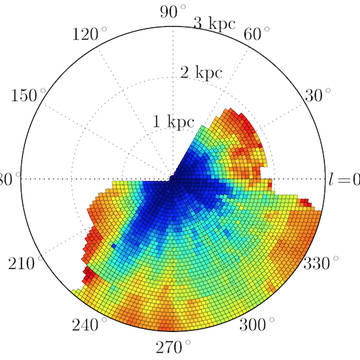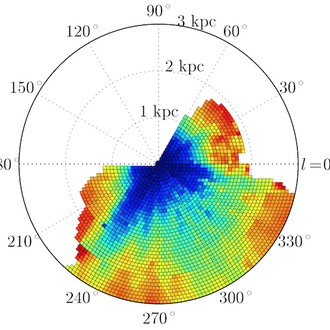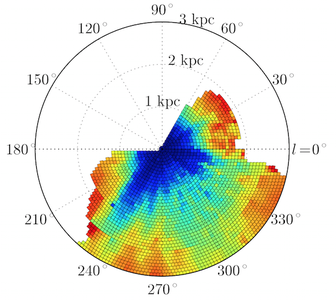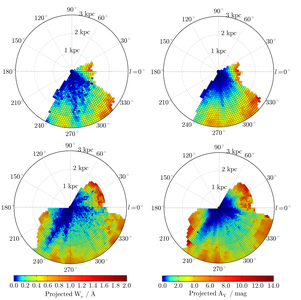New Milky Way Maps from RAVE data
Using data from the RAVE survey, a large observation project initiated and led by the Leibniz Institute for Astrophysics Potsdam (AIP), an international team of astronomers has produced new maps of the material between the stars in the Milky Way that should move astronomers closer to cracking a stardust puzzle that has vexed them for nearly a century.
The maps and an accompanying journal article appear the issue of the journal Science on 15 August 2014. The researchers say their work demonstrates a new way of uncovering the location and eventually the composition of the interstellar medium, which refers to the material found in the vast expanse between star systems within a galaxy.
This material, including dust and gas composed of atoms and molecules are left behind when a star dies. They also become the building blocks of new stars and planets. Analyzing rainbow-colored bands of starlight that have passed through space gives astronomers important information about the makeup of the space materials that the light has encountered. In 1922, a grad student’s photographs yielded some dark lines indicating ‘missing’ starlight, which must have been absorbed by a yet unknown source. These features were called diffuse interstellar bands (DIBs). Since then, scientists have identified more than 400 of these diffuse interstellar bands, but the material that is causing these bands to appear and their precise location have remained a mystery.
The nature of this puzzling material is important to astronomers because of the clues it could give about the physical conditions and chemistry of these regions between stars, critical components in theories of how stars and galaxies are formed. Researchers have speculated that the absorption of starlight that creates these dark bands points to the presence of unusually large complex molecules, but the proof has remained elusive. More concrete clues should emerge from the new pseudo-3D maps of the DIB-material within our Milky Way Galaxy produced by the 23 scientists who contributed to the Science article.
The maps were assembled from data collected over a 10-year period by the Radial Velocity Experiment (RAVE). The survey provided the mapmakers in the current project with data related to 500,000 stars. The vast size of the sample enabled the mapmakers to determine the distances of the material causing the DIBs and thus how it is distributed throughout the Milky Way Galaxy.
“With the wide area coverage of the spectroscopic survey RAVE it was for the first time possible to map out the three dimensional distribution of the DIBs” said Matthias Steinmetz of the Leibniz Institute for Astrophysics Potsdam (AIP), principle investigator of the RAVE survey. “We could show that the complex molecules responsible for the DIB features can also be found at larger distances to the Galactic plane than it is the case for interstellar dust”.
Janez Kos and Tomaz Zwitter of the University of Ljubljana in Slovenia led the astronomy team that produced this paper.
RAVE is a multinational project with participation of scientists from Australia, Germany, France, UK, Italy, Canada, the Netherlands, Slovenia and the USA, coordinated by the Leibniz Institute for Astrophysics Potsdam (AIP), Germany. Funding of RAVE which guarantees extensive data, telescope and instrument access is provided by the participating institutions and the national research foundations.
Science Contact AIP: Prof. Dr. Matthias Steinmetz, msteinmetz@aip.de, +49 331 7499 381
Contact to first authors of the publication: Janez Kos, University of Ljubljana, janez.kos@fmf.uni-lj.si, +386 1 4766 507
Media Contact AIP / RAVE: Dr. Gabriele Schönherr / Kerstin Mork, presse@aip.de, +49 331 7499 469
Related link: The Radial Velocity Experiment (RAVE)
Using data from the RAVE survey, a large observation project initiated and led by the Leibniz Institute for Astrophysics Potsdam (AIP), an international team of astronomers has produced new maps of the material between the stars in the Milky Way that should move astronomers closer to cracking a stardust puzzle that has vexed them for nearly a century.
The maps and an accompanying journal article appear the issue of the journal Science on 15 August 2014. The researchers say their work demonstrates a new way of uncovering the location and eventually the composition of the interstellar medium, which refers to the material found in the vast expanse between star systems within a galaxy.
This material, including dust and gas composed of atoms and molecules are left behind when a star dies. They also become the building blocks of new stars and planets. Analyzing rainbow-colored bands of starlight that have passed through space gives astronomers important information about the makeup of the space materials that the light has encountered. In 1922, a grad student’s photographs yielded some dark lines indicating ‘missing’ starlight, which must have been absorbed by a yet unknown source. These features were called diffuse interstellar bands (DIBs). Since then, scientists have identified more than 400 of these diffuse interstellar bands, but the material that is causing these bands to appear and their precise location have remained a mystery.
The nature of this puzzling material is important to astronomers because of the clues it could give about the physical conditions and chemistry of these regions between stars, critical components in theories of how stars and galaxies are formed. Researchers have speculated that the absorption of starlight that creates these dark bands points to the presence of unusually large complex molecules, but the proof has remained elusive. More concrete clues should emerge from the new pseudo-3D maps of the DIB-material within our Milky Way Galaxy produced by the 23 scientists who contributed to the Science article.
The maps were assembled from data collected over a 10-year period by the Radial Velocity Experiment (RAVE). The survey provided the mapmakers in the current project with data related to 500,000 stars. The vast size of the sample enabled the mapmakers to determine the distances of the material causing the DIBs and thus how it is distributed throughout the Milky Way Galaxy.
“With the wide area coverage of the spectroscopic survey RAVE it was for the first time possible to map out the three dimensional distribution of the DIBs” said Matthias Steinmetz of the Leibniz Institute for Astrophysics Potsdam (AIP), principle investigator of the RAVE survey. “We could show that the complex molecules responsible for the DIB features can also be found at larger distances to the Galactic plane than it is the case for interstellar dust”.
Janez Kos and Tomaz Zwitter of the University of Ljubljana in Slovenia led the astronomy team that produced this paper.
RAVE is a multinational project with participation of scientists from Australia, Germany, France, UK, Italy, Canada, the Netherlands, Slovenia and the USA, coordinated by the Leibniz Institute for Astrophysics Potsdam (AIP), Germany. Funding of RAVE which guarantees extensive data, telescope and instrument access is provided by the participating institutions and the national research foundations.
Science Contact AIP: Prof. Dr. Matthias Steinmetz, msteinmetz@aip.de, +49 331 7499 381
Contact to first authors of the publication: Janez Kos, University of Ljubljana, janez.kos@fmf.uni-lj.si, +386 1 4766 507
Media Contact AIP / RAVE: Dr. Gabriele Schönherr / Kerstin Mork, presse@aip.de, +49 331 7499 469
Related link: The Radial Velocity Experiment (RAVE)
Images
Detail: DIBs map.
Maps of the measured DIB absorption in respect to the area they cover in our galaxy.
Big screen size [1000 x 993, 610 KB]
Original size [3025 x 3005, 2.1 MB]






